The best way I have found to describe Prana is your vitality, the life energy that all beings have. Prana is the life force within the breath, the energy of life. It permeates through the whole universe and originates from the creator.
Prana is the vital force that makes up the entire cosmos; it is the Parashakti or cosmic power, it is the original creative power. The entire universe is a manifestation of prana.
We take in Prana through the food we eat, fresh vegetables are full of prana. Older vegetables have less prana. We get prana from the sun, but too much prana from the sun will make you feel listless and floppy, also sunburn is from too much prana.
The oxygen atom is soaked with prana, a subatomic particle charged with life energy. When we breath in oxygen we are breathing in life giving energy. The oxygen gets diffused in the lungs, then into the bloodstream, and takes the prana throughout the body. It enters every area—physical, vital, and mental. That is why correct breathing is so important. When we cease to breath in prana, we die.
Pranayama is the regulation of the prana, or life force. Breath is the external manifestation of the prana.
A strong ratio to elevate prana is the pranayama, or breath control of 1:4:3 Puraka: 1, Kumbhaka: 4, Rechakam: 3 or Inhalation: 1, Retention: 4, Exhalation: 3
The pranamaya kosha is composed of the five pranas, also called vayus or “forces of the air.”
The 5 Vayus or Winds
Prana Vayu
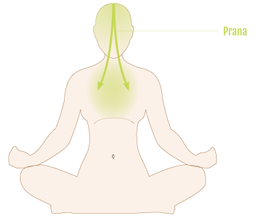
Prana vayu moves downwards and inwards. Some sources say it is centered in the heart region, some in the region of the third eye but its movement is in the thoracic region, maintaining the heart, lungs, breathing, swallowing and blood circulation. Prana-vayu concerns what we absorb through our senses, what we see and hear, what we eat and drink and what we breathe. It is activated by the inward breath.
Prana Vayu is weakened by sensory overload, like loud noise, angry or sad songs, violent T.V. shows & video games or bad news. An agitated mind can’t settle into meditation. A strong Prana Vayu allows you to cultivate peace and quiet and a meditation practice. Meditation is excellent for activating and balancing prana vayu.
some asanas for Prana vayu are:
- heart opening backbends eg: bow pose, camel pose, cobra pose, dancer pose, and bridge pose.
- Virabhadrasana I (warrior I)
- Utkatasana (chair pose)
- Utthita hastasana (arms raised overhead)
- Anjaneyasana (crescent lunge)
- Savasana (corpse pose)
Apana Vayu
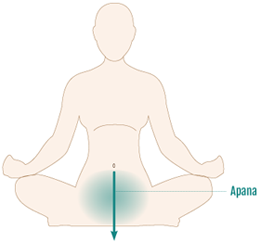
Apana vayu governs the movement of energy from the navel down to the pelvic floor or root chakra at the base of the spine. Apana vayu is responsible for elimination. It moves down and out and also helps retain things in. It governs the elimination of urine and poop, semen, menstrual fluid, and child birth, It is activated by the outward breath and expels carbon dioxide. On a deeper level, it rules the elimination of negative sensory, emotional, and mental experiences.
Yoga for Apana Vayu:
Apana Breath: Inhale: Pull the energy into the belly Exhale: Direct the energy from the belly into the feet/ground Hold the air out for a moment with your attention on the root chakra. Repeat a few times
Disfunction of Prana and Apana Vayu. You can see that the prana is disunited. Mind and body are disconected
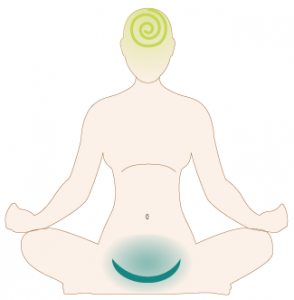
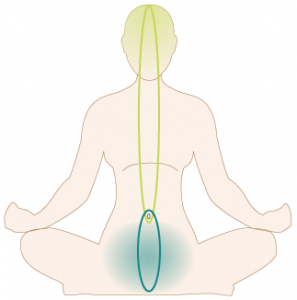
Here the breath is united at the navel. Connection between Prana vayu and Apana vayu allows the mind and body to work in harmony.
Yogic practices work to bring Apana vayu up to unite with Prana vayu and draw Prana vayu down to unite with Apana vayu, which occurs in the region of the navel – the pranic center of the body.
What we ingest through our eyes and ears is just as important for our well being as what we eat and drink.
Samana Vayu
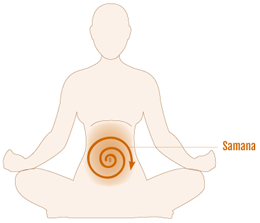
Samana vayu unites the upward energy of prana and the downward energy of apana.
It digests, absorbs and assimilaties. In the stomache, it aids in the digestion of food. In the lungs, it aids to digest air or absorb oxygen. In the mind it aids to digest experiences — sensory, emotional, and mental. It helps us connect to our gut, stoking our inner fire and confidence.
Breathing into the belly allows us process difficulties, then they become learning experiences and we can let go of negativity (via apana vayu)
It can sometimes be difficult to allow the breath into the belly as we have been taught to suck in our bellies, but it is good to relax the muscles of your tummy and explore the movement of Prana.
Some asanas for activating this life energy are:
- twists and
- abdominal work
- arm balances eg crow
- chair pose
- reclining abdominal twist
- boat pose.
Vyana Vayu
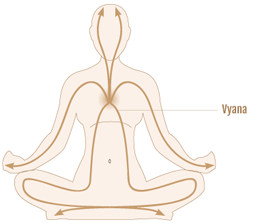
Vyana Vayu is centered in the heart and lungs. Vyana Vayu governs the movement of energy throughout the entire body and the energy that radiates out from our body. It moves food, water, and oxygen throughout the body, and keeps our emotions and thoughts circulating in the mind, imparting momentum and providing strength.
This vayu dictates the blood flow and the electrical impulses through our nervous system and the movement of fluid through the lymphatic system.
Vayana vayu is responsible for distribution. It moves outward in a circular, pulsating motion.
Practices that benefit Vyana vayu include:
۰Focus on Inhalation and expansion.
۰Retention of breath (hold after Inhale).
۰Activities that give you joy, or touch your heart.
A breathing practice:
Inhale: Let the breath draw from the nose to the heart, and even move to the back of the heart (into the deepest, darkest corners).
Exhale: Imagine the breath moving out through the arms and legs and through the length of the torso. Imagine the breath moving out through every pore in the body, expanding you beyond the boundary of your skin.
Asanas for balancing Vyana vayu are:
- Backbends
- lateral postures (side bends)
- Surya Namaskar (sun salutations)
- Savasana
Udana Vayu
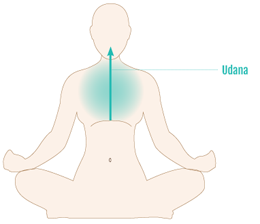
Udana vayu raises the energy from the navel up to the head. Udana Vayu works through the throat center. It affects the thyroid and parathyroid glands, which regulate metabolism, the intake of air and food, communication, and confidence in expressing ourselves. It governs the growth of the body, the ability to stand and speak; our effort, enthusiasm, and will. It is our positive energy and helps us to evolve in consciousness. it brings prana to the energy centers deep in our brain and the central axis of the subtle body.
Asanas for Udana Vayu:
Backbends, particularly belly backbends,
can activate udana vayu
- Setu Bandha Sarvangasana (Bridge Pose)
- Matsyasana (Fish Pose)
- Sarvangasana (Shoulderstand)
- Halasana (Plow Pose)
- Sirsasana (Headstand).
How to Direct Prana Through Udana Vayu:
In standing, lying and seated postures: Inhale: Imagine pranic energy moving up from the ground through the soles of the feet, moving up the legs, up the air channels of the back and up into the chest.
Exhale: Invite the energy to continue moving upward through the crown of your head. Inhale: Imagine pranic energy moving up from the ground through the soles of the feet, moving up the legs, up the air channels of the back and up into the chest.
Exhale: Let the breath release through the throat region as you exhale through the nose, releasing any tension in the throat, jaw, and teeth.
For inverted postures:
Inhale: Visualize that the pranic energy is beginning at the hands or arms, or whatever part of your body is in contact with the floor. Let it continue moving up the arms and torso as you lengthen your inhale.
Exhale: Move the breath through the legs and out through the soles of the feet. Using this breathing technique can be particularly helpful in asanas where you feel compressed in the neck, arms, and shoulders like Halasana and Sarvangasana.

Prana brings in the fuel, samana converts this fuel to energy, and vyana circulates the energy to various worksites. Apana disposes of the waste products produced by the conversion process. Udana manages the energy thus created, enabling the machine to function effectively.
The Vayus and Corresponding Chakras


5 Vayus or Winds – summary
Prana Vayu
• Ajna chakra
• chest region
• The flow is inwards and upward
• concerned with how we absorb or receive things -food, drink, senses, stimulus
• as you inhale feel an energy flowing up the torso from the belly to the third eye.
• Asanas to lift, lengthen and open the upper body
Apana Vayu
• Muldahara and Svadishthana chakra
• Pelvic floor
• Flow is downwards
• organs of digestion, reproduction & elimination
• as you exhale feel an energy flowing down the torso from the top of the head to the tailbone.
• Asanas to ground and stabilize the lower body
Vyana Vayu
• Anahata chakra
• begins in the heart and lungs and flows through all the body
• as you inhale feel the breath radiating outward from the navel to the arms and legs.
• Asanas to focus on strength and fluid movement of the body
Udana Vayu
• Vishuddhi chakra
• Throat
• governs speech, self-expression and growth
• has a circular flow around the neck and head
• as you inhale and exhale feel the breath circulating around and through the head and neck.
• Asanas to maintain a long spine and a correct posture
Samana Vayu
• Manipura chakra
• abdomen
• energy moves from the periphery of the body to the centre
• assimilation of all substances: food, air, experiences, emotions and thoughts
• as you inhale and exhale feel the breath rising and falling in the front, sides and back of the torso
• Asanas to open and relax the body